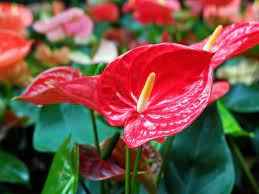
Laurie’s Pick for Favorite Plant

Flamingo Lily
1) Plant Common name – Flamingo Lily or Painter’s Palette or Laceleaf
2) Plant Botanical name – Anthurium (arum family)
3) What makes this plant amazing? Produce long lasting flowers and has attractive foliage.
4) How much light does it need? Anthuriums will take about as much light as you can provide them as long as it is not direct sunlight. Lower levels of light will slow down or cease flower production.
5) Does it like water all the time or does it like to be dry? Anthuriums are able to handle dryness around the root ball but need to be watered thoroughly and allowed to dry slightly before watering again. Allowing the plant to dry out will greatly slow down the growth cycle. Drying out can also cause the tip of the leaves to burn and root damage. Overwatering can also cause root damage and sudden yellowing of leaves.
6) How large does it grow? Anthurium can grow to 2-3 feet tall, although the dwarf forms are smaller.
8) Does it have something that makes it unique? It has a very unique, long-lasting flower.
9) Do you need to fertilize? With what and how often? It is best to fertilize your plant every 1-2 weeks with a water-soluble blooming plant fertilizer.
11) Does it have a fragrance? Some may notice a slight fragrance, but it is not necessarily considered a characteristic of the plant.
12) Is it poisonous to pets? Chewing or biting into Anthurium will release calcium oxalate crystals causing tissue penetration and irritation to the mouth and GI tract.
13) Ease of growing? Easy or more difficult to maintain & grow? Anthuriums are relatively easy to grow. They are durable and will survive as an indoor foliage plant for a remarkable period, even under adverse conditions.
14) Can it go outside for summer/inside for winter? Anthurium grow best with day temperatures of 78 to 90 F. Night temperatures below 40 F can result in slow growth and yellowing of lower leaves.
15) Can it be propagated easily? The easiest way to propagate an anthurium is through root propagation. If you’ve got an overcrowded pot, split it up during early spring for the best results.




